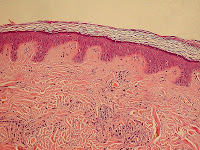Human skin has two important and main layers, dermis and epidermis with different physiology and function.
Epidermis, the outermost layer of skin, functions as a chemical and physical barrier between the interior of the body and external environment.Skin physiology: function of epidermis in protection
The main action of bottom most layer of epidermis, which lies adjacent to dermis, is the cell multiplication.The new cells progressively move towards the outer layers, simultaneously maturing and differentiating.
The physiology and shape of the cells also changes and by the time they reach the top most layer, they are flattened, lacking nuclei they become lifeless.
At this stage they are called corneocytes and are filled with keratin proteins capable of water retention and also lipids.
The outer most layer, which contains 10-30 layers of stacked corneocytes, is called Stratum Corneum and is semi-permeable, becoming a barrier between the interior of the skin and external surroundings.
Epidermis physiology also includes functions as physical barrier protecting the internal tissues from bacterial invasion, physical abrasion and ultraviolet rays.
Skin physiology: function of epidermis in thermoregulation, excretion and sensation
In hot weather, skin physiology is tuned to produce sweat.Sweat on reaching the epidermis surface, evaporates cooling the surface by the latent heat of evaporation.
In response to low temperatures, sweat is decreased and blood flow to the skin is increased to maintain the temperature.
Besides removing excess water and temperature control, the sweating process also removes smaller quantities of waste salts and many organic compounds.
The nerve fibers (Merkel cells) reach upto the outer most layer of dermis and stratum basale and pick up sense signals of touch, temperature, pain and pressure.
Skin physiology: function of epidermis in immunity
Certain specialized cells of epidermis, Langerhans cells, have immune functions.Though these cells originate from bone marrow, they migrate to epidermis layers.
These dendritic cells have Birbeck granules.
They interact with white blood cells (helper T cells) and help in destroying the invading organisms.
Apart from detection of foreign bodies, Langerhans' cells, have a major role in the physiology of allergies.
Skin physiology: function of epidermis in skin coloration
The black-brown melanin pigment, is produced by the melanocytes present in basal layer of epidermis.Melanocytes comprise up to 10% of the cells in epidermis.


The slender projections of melanocytes extend to keratinocytes and help in the transfer of melanin granules.
Melanin granules apart from imparting color to skin also protect it from UV rays.
Melanin granules clump on the surface side of keratinocytes, protecting the nucleus from UV light and genetic damage.
The scattering and absorbing of Uv rays by melanin protects the internal cells by blocking free radical formation and damage.
Thus with multiple functions, epidermis plays a major role in skin physiology.
No comments:
Post a Comment